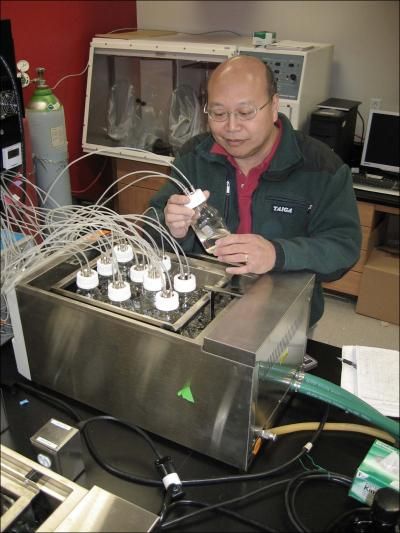
Mar. 29, 2008
Cleaning up spills — naturally
BIO scientist researches ways to speed up oil-scrubbing action of waves, micro-organisms
By BRIAN HAYES
 |
| Research scientist Kenneth Lee uses a respirometre to measure degradation of hydrocarbons. He is researching the use of natural methods to clean up oil spills. (BRIAN HAYES) |
DELIBERATELY pouring 200 litres of crude oil onto broken ice in the Gulf of St. Lawrence could be a sure way to land in jail or empty a pocketbook.
But it’s all in the line of work for Kenneth Lee, a Department of Fisheries and Oceans research scientist at the Bedford Institute of Oceanography who is evaluating new technologies for cleaning up oil spills in northern waters.
"It’s a major concern when you have an oil spill in ice-infested waters because it’s very difficult to clean up," Mr. Lee said of several experiments to test a new technique he and his colleagues in the Canadian Coast Guard recently carried out in Gulf waters about 16 kilometres off Matane, Que.
Traditional methods like using skimmers don’t work very well in cold environments because the oil is very heavy and the ice itself may damage equipment, said the scientist with the Centre for Offshore Oil and Gas Environmental Research.
Nor is burning a solution, because slicks are generally cooled by surrounding waters, making them difficult to ignite.
"Even if pools of oil trapped among the ice are set ablaze, there’s also the problem of smoke and air pollution," he said.
"For years in our lab, we’ve been looking at oil spills and trying to understand what happens to them naturally," he said. "We know oil is nothing new in the environment," he added of natural oil seeps in the world’s oceans.
"If it wasn’t for bacteria breaking it down, we probably would be knee-deep in oil."
Mr. Lee’s contributions to cleanup technologies are based on speeding up what nature does naturally.
He said vast improvements in cleanup techniques stemmed from lessons learned after the Exxon Valdez sank in 1989 off Alaska.
"We’ve done a lot of work on bioremediation of oil spills," he said.
Bioremediation involves adding nutrients to speed the bacterial degradation of oil. It has proven successful in Alaska and elsewhere.
In fact, international guidelines have now been established for its use.
In areas of rocky shorelines in Alaska, Mr. Lee said winter storms helped the recovery process. Pounding waves removed much of the oil and dispersed it into the ocean in concentrations below toxic levels, which allowed bacterial degradation to occur.
Researchers were also surprised to find some beaches could clean themselves — even through there wasn’t a lot of wave activity.
On those beaches, they found that oil was released in microscopic droplets that were mixed with clay particles found naturally in beach sediment. As a result, the oil droplets adhered less, so they could be dispersed into the ocean with limited wave action.
Recognizing the significance of this, researchers realized that oiled sediments containing fine mineral particles like clay that were stranded at the high water mark could be excavated and deposited along the shoreline. There, waves promoted the formation of oil-mineral aggregates that were then dispersed into the ocean.
"This was a cost-effective cleanup procedure as the shoreline was returned to its natural state over time as the sediments were transported back up the beach by successive tides following oil removal, he said.
"We looked at that and felt that’s unique because we know that oil is only attacked by bacteria at its surface," he said. "So if you have oil in small droplets, you increase its surface area and we know bacteria can attack it much more quickly."
Lab tests revealed formation of oil-mineral aggregates could occur at low temperatures, such as those in ice-covered waters.
An accidental oil spill from a ship navigating through ice in the Saguenay Fjord a few years ago provided a rare opportunity to evaluate the concept.
Following up Mr. Lee’s suggestion, a Canadian Coast Guard icebreaker applied clay to the oil-covered ice.
"They could actually see clay-oil flocculation (the formation of oil mineral aggregate) and very small microscopic droplets of oil being formed and going into the water column and being diluted during their icebreaking operations," he said.
When the ice in the fjord broke up in the spring, there was no evidence of oil reaching the coastline.
Scientific studies under controlled conditions are required to fully evaluate the effectiveness of the procedure, he said.
A few weeks ago, Mr. Lee and his colleagues went to Quebec to conduct further tests. Bags of calcite, a fine mineral used to make concrete, were mixed with seawater in tanks aboard a Coast Guard ship and sprayed through fire hoses on oil released into the environment.
As expected, oil-mineral aggregates formed. Like a giant mixer, the ship’s propeller provided the energy to shear the oil slick into small droplets.
"We measured concentrations of oil in the water column at the spill site and adjacent areas over time," he said. "Due to natural dilution processes associated with tides and currents, oil concentrations in the water were well below toxicity limits.
"We also collected sediments adjacent to the area where we conducted the experiments and at no time did we observe concentrations of hydrocarbons above the established regulatory values for ocean disposal," Mr. Lee said.
"So it seems the experiment was a success," he said the of the coast guard’s interest in developing the "promising technology" further. Mr. Lee said researchers are now conducting laboratory experiments using different concentrations of mineral finds and types of oil under a diverse range of experimental conditions to determine how the new technology will work and under what situations.